Enigmatic Symbols and Carvings in Man-Made Royston Cave
The Royston Cave is an artificial cave in Hertfordshire, England, which contains strange carvings. It is not known who created the cave or what it was used for, but there has been much speculation. Some believe that it was used by the Knights Templar, while others believe it may have been an Augustinian store house. Another theory posits that it was a Neolithic flint mine. None of these theories have been substantiated, and the origin of Royston Cave remains a mystery.
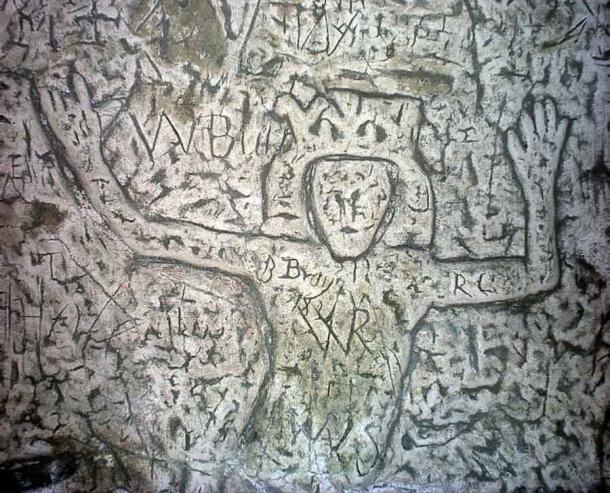
Detail of Royston Cave, Royston, Hertfordshire. (Cruccone / CC BY-SA 3.0)
The Discovery of Royston Cave
Royston Cave was discovered in August 1742 by a worker in the small town of Royston digging holes to build footing for a new bench at a market. He discovered a millstone while he was digging, and when he dug around to remove it, he found the shaft leading down into a man-made cave, half-filled with dirt and rock.
At the time of discovery, efforts were made to remove the dirt and rock filling the artificial cave, which was subsequently discarded. Some believed that treasure would be found within Royston Cave. However, removal of the dirt did not reveal any treasure. They did however discover sculptures and carvings within the cave. It is worth noting that had the soil not been discarded, today’s technology could have allowed for a soil analysis.
- Ten Amazing Caves of the Ancient World
- More than a Dozen Mysterious Prehistoric Tunnels in Cornwall, England, Mystify Researchers
Located below the crossroads of Ermine Street and Icknield Way, the cave itself is an artificial chamber carved into chalk bedrock, measuring approximately 7.7 meters high (25 ft 6 in) and 5.2 meters (17 ft) in diameter. At the base o the cave is a raised octagonal step, which many believe was used for kneeling or prayer. Along the lower part of the wall there are unusual carvings. Experts believe that these relief carvings were originally colored, although due to the passage of time only very small traces of color remain visible.
The carved relief images are mostly religious, depicting St. Catherine, the Holy Family, the Crucifixion, St. Lawrence holding the gridiron on which he was martyred, and a figure holding a sword who could either be St. George, or St. Michael. Holes located beneath the carvings appear to have held candles or lamps which would have lit the carvings and sculptures. Several of the figures and symbols have yet to be identified, but according to Royston Town Council, a study of the designs in the cave “suggest that the carvings were likely made in the mid-1300s.”
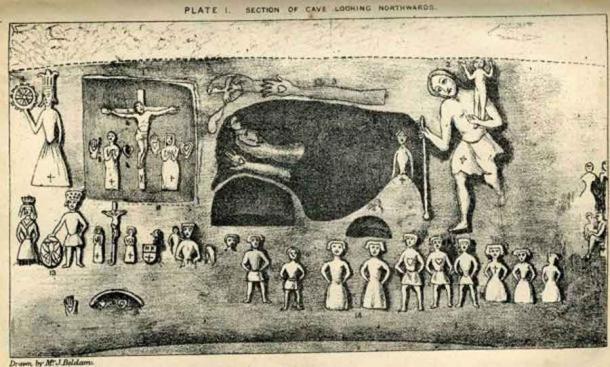
Plate I from Joseph Beldam's book The Origins and Use of the Royston Cave, 1884 showing some of the numerous carvings. (Public domain)
Theories Related to Royston Cave
One of the main theories as to the origin of Royston Cave, especially for those who like conspiracy theories, is that it was used by the medieval religious order known as the Knights Templar, prior to their dissolution by Pope Clement V in 1312. Bad Archaeology criticizes the way websites across the web have repeated this association between the Royston Cave and the Knights Templar, “despite the weakness of the evidence in favor of the hypothesis and the arguments in favor of a later date.”
Some believe that the cave had been split into two levels using a wooden floor. Figures near a damaged section of the cave depict two knights riding a single horse, which may be the remains of a Templar symbol. Architectural historian Nikolaus Pevsner has written that the date of the carvings "is hard to guess. They have been called Anglo-Saxon, but are more probably of various dates between the C14 and C17 (the work of unskilled men)."
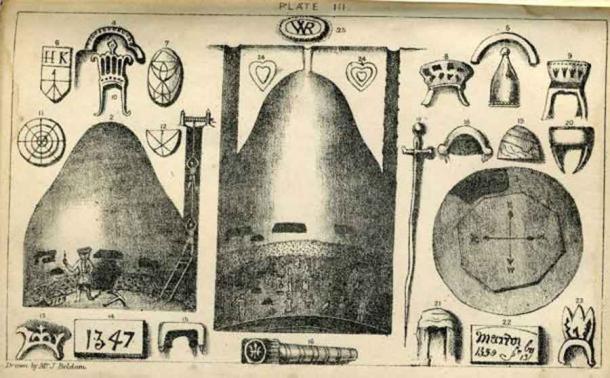
Plate III from Joseph Beldam's book The Origins and Use of the Royston Cave, 1884 showing the shape and floor plan of the cave. (Public domain)
Another theory is that Royston Cave was used as an Augustinian store house. As their name implies, the Augustinians were an Order created by St. Augustine, Bishop of Hippo, in Africa. Founded in 1061 AD, they first came into England during the reign of Henry I. From the 12th century, Royston in Hertfordshire was a center of monastic life and the Augustinian priory continued without break there for nearly 400 years. It has been said that local Augustinian monks used Royston Cave as a cool storage space for their produce and as a chapel.
Finally, some speculate it may have been used as a Neolithic flint mine as early as 3,000 BC, where flint would have been gathered for making axes and other tools. However, the chalk in this area only provides small flint nodules, generally unsuitable for axe making, so this may cast some doubt on this theory.

Relief carving of St. Christopher at Royston Cave. (picturetalk321 / CC BY-NC-ND 2.0)
Unravelling the “Mysteries” of Royston Cave
To this date there remains much mystery as to who created Royston cave and for what purpose. It is always possible that whichever group originally created the cave may have abandoned it at some point, allowing it to be used by another group. The mystery surrounding the cave and the sculptures within makes the cave an interesting location for visitors who would like to speculate as to the origins of this ancient wonder.
- The Wemyss Caves: Ancient Pictish History and the Writing on the Walls
- Fingal’s Cave: Legends and Inspiration Near the Scottish Sea
Royston Cave has required regular maintenance and restoration, as it was discovered that insect larvae and worms were damaging the walls and structure of the cave. By August 2014, work to prevent such damage was deemed successful. Rather than using insecticides, the preservation workers removed some of the earth, thereby eliminating the worms’ food supply. Hopefully subsequent repair work to pipes to avoid flooding, and other work to prevent vibration damage from the traffic above, will help to preserve the cave into the future.
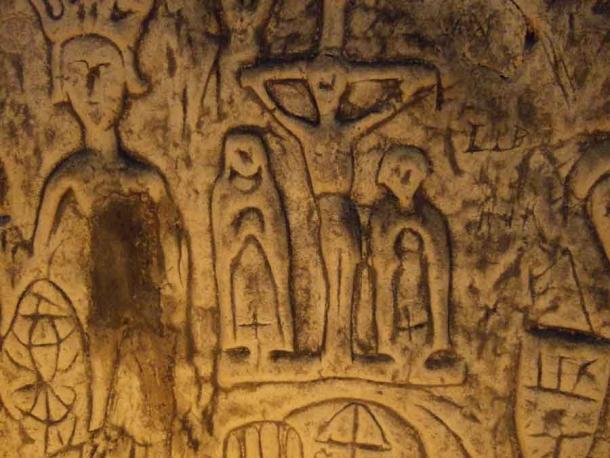
Depiction of the crucifixion at Royston Cave. (picturetalk321 / CC BY-NC-ND 2.0)
Visiting the Royston Cave
Just 8 minutes walking from Royston train station, visits are organized by Royston Town Council and tickets must be booked online. Their opening hours of Royston Cave are limited to Saturdays and Sundays from April to September. Each tour is limited to 15 people and lasts about 30 minutes.
Top image: The mysterious and elaborately carved walls of Royston Cave. Source: Sizbut / Flickr
By M R Reese
















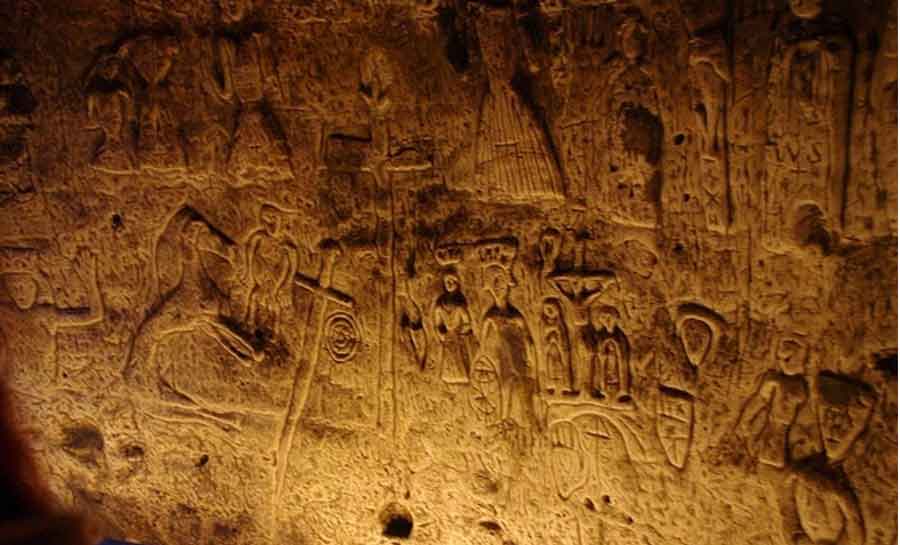

Comments
This 'Cave' is a really a 'pit'. Entrance would have been precarious in it's origin, from only the top. It is very curious for many reasons. Because of the Christian themes and extensive work involved, I think this is the work of possible one artist, though he/she may have repurposed an existing cavern. That purpose is also curious because it shows great creativity with limited literacy and artistic training. If I had opportunity to see this, I would. Like Justbod said, speculation is a lot more interesting than ultimately discovering the truth. Somethings just deserve mystery.
Could the cave have been home to an anchorite, or anchoress? The carvings and candle holders suggest the cave was used for some sort of religious practice. A recluse, who lived alone, might have done the carvings and made the candle holders as part of his religious practice. There would be evidence of an anchorite or anchoress in or near the cave. Possibly it was removed during the first excavation. But this seems to me like a very probable hypothesis.
Well with all the stylized hearts, swords, & crosses (especially on pelvic regions), I doubt this was originally an Augustinian storehouse with all the female figures portrayed, unless the monks were allowed to marry, which is highly unusual/unlikely for a monastic order. With all the crowns, women in dresses, & men with swords perhaps it does depict a royal/religious family. Could be some secretive Templars preserving their family history or recording who they were serving. Because of the clothes & symbols depicted, I agree that these carved images can be no older than the so-called dark ages or early middle ages of English history.
Judging by the diagrams showing the shape of the interior of the cave - especially the flutes / chimneys appearing to exit out the top - and perhaps even more importantly the assortment of crowns and helmets depicted - I would hazard to guess that Royston cave was used as an athanor in the "purification" (ritual sacrifice) of human beings.
See Torrigiani Athanor: youtube.com/watch?v=MYFshuyr8ic
Very interesting thank you! I'd never heard of this place before. Like the previous comment from RBflooringinstall, it does sound like it's a space that has been reused over very many years.
I love that there are so many interesting enigmas and mysteries out there that will possibly never be solved. Sometimes the speculation is a lot more interesting than ultimately discovering the truth!
Sculptures, carvings & artwork inspired by a love of history & nature: www.justbod.co.uk
Pages